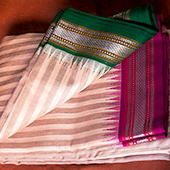Design Resource
Karvat Kathi Saree Weaving - Nagpur, Maharashtra
Saw-edged Saree
by
Prof. Bibhudutta Baral and Srikanth B.
The sari is one of the most primitive styles of unstitched garment used since Indus Valley Civilization, being a precursor for the patterns created even today. Over the millennia, it has become aesthetic wear for women and a canvas for weavers and printers to make artistic patterns, prints, and jeweled embellishments. According to legends, both the cotton fiber and the art of weaving reached India from the Mesopotamian civilization. Hence the civilians from the contemporary Indus Valley Civilization were familiar with the fibers and wore long loincloths. Many other civilizations also found women wearing these loin cloths around their waist, leaving the upper body bare, except in cold climates when animal skins or woolen shawls were used. Their style of draping was generally in Kachcha style, in which after the cloth goes around the waist, the person takes one end of the cloth or the center pleat between the legs and tucks it up behind for free movement of the lower body and the legs. Early history records that this style of clothing was not only limited to Mesopotamia or the Indus Valley but was common to Egypt, Sumer, and Assyria. Archives underline the role of Aryans too, who, after moving southwards from north India, adopted the practice of wearing cotton cloths, structurally similar to the Indus Valley clothing style. These rich influences also moved medieval India; hence the royal families preferred the most delicate fabrics that induce their splendor into the work. Thus the works of the master weavers were greatly looked upon by the craftsmen of coming ages, for their detailing and metal embellishments. Therefore Indian textile art is still held high in the annals of trade around the world.
The Karvat Kathi sarees and fabrics curated in Maharashtra originated in the Vidarbha region of the state, which is now an indispensable part of their culture and livelihood. This unique style is auspicious wear for various religious occasions like marriage, Diwali, baby shower celebration, etc. Tassar cocoon is a type of silk widely used in the making of Karvat Kathi saree. The silk cultivated exclusively in the areas of Bhandara is highly regarded for its quality and colour, attained mainly due to the resources and climate conditions of the region. The Tassar Karvat Kathi Saree is woven with three shuttles weaving, where the border is woven with cotton yarn, and the body with pure Tussar hand reeled silk. The temple designs throughout the borders produced in various sizes are what make this style stand out from other weaving styles. Under the instructions of Mr. Y. K. Suryavanshi, Deputy Director at Nagpur-based Weavers Service Center, senior artisans like Mr. Pasan Shetty, Mr. Gajanan Dhekate, and many others employed at the center create this aesthetically upfront piece of art. They supply their produce to various state-owned handloom showrooms like Indrayani, a center run by the Government of Maharashtra.










